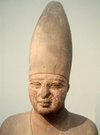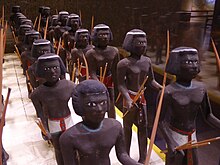| Eleventh Dynasty of Egypt | |||||||||
|---|---|---|---|---|---|---|---|---|---|
| c. 2150 BC–c. 1991 BC | |||||||||
 Funerary stele of Intef II, on display at the Metropolitan Museum of Art. Funerary stele of Intef II, on display at the Metropolitan Museum of Art. | |||||||||
| Capital | Thebes | ||||||||
| Common languages | Egyptian language | ||||||||
| Religion | ancient Egyptian religion | ||||||||
| Government | Absolute monarchy | ||||||||
| Historical era | Bronze Age | ||||||||
| • Established | c. 2150 BC | ||||||||
| • Disestablished | c. 1991 BC | ||||||||
| |||||||||
The Eleventh Dynasty of ancient Egypt (notated Dynasty XI; c. 2150 BC – c. 1991 BC) is a well-attested group of rulers. Its earlier members before Pharaoh Mentuhotep II are grouped with the four preceding dynasties to form the First Intermediate Period, whereas the later members are considered part of the Middle Kingdom. They all ruled from Thebes in Upper Egypt.
Characteristics
The relative chronology of the 11th Dynasty is well established by contemporary attestations and, except for count Intef and Mentuhotep IV, by the Turin canon.
Manetho's statement that the 11th Dynasty consisted of 16 kings, who reigned for 43 years is contradicted by contemporary inscriptions and the evidence of the Turin King List, whose combined testimony establishes that this kingdom consisted of seven kings who ruled for a total of 143 years. However, his testimony that this dynasty was based at Thebes is verified by the contemporary evidence. It was during this dynasty that all of ancient Egypt was united under the Middle Kingdom.
This dynasty traces its origins to a nomarch of Thebes, "Intef the Great, son of Iku", who is mentioned in a number of contemporary inscriptions. However, his immediate successor Mentuhotep I is considered the first king of this dynasty.
An inscription carved during the reign of Wahankh Intef II shows that he was the first of this dynasty to claim to rule over the whole of Egypt, a claim which brought the Thebans into conflict with the 10th-Dynasty rulers of Herakleopolis Magna. Intef undertook several campaigns northwards, and captured the important nome of Abydos.
Warfare continued intermittently between the Theban and Heracleapolitan dynasts until shortly before the 39th regnal year of Nebhepetre Mentuhotep II, when the Herakleopolitans were defeated, and this dynasty could begin to consolidate their rule. The rulers of the 11th Dynasty reasserted Egypt's influence over her neighbors in Africa and the Near East. Mentuhotep II sent renewed expeditions to Phoenicia to obtain cedar. Sankhkare Mentuhotep III sent an expedition from Coptos south to the land of Punt.
The reign of its last king, and thus the end of this dynasty, is something of a mystery. Contemporary records refer to "seven empty years" following the death of Mentuhotep III, which correspond to the reign of Nebtawyre Mentuhotep IV. Modern scholars identify his vizier Amenemhat with Amenemhat I, the first king of 12th Dynasty, as part of a theory that Amenemhat became king as part of a palace coup. The only certain details of Mentuhotep's reign was that two remarkable omens were witnessed at the quarry of Wadi Hammamat by the vizier Amenemhat.
Pharaohs of the Eleventh Dynasty
| Pharaoh | Horus name | Image | Reign | Burial | Consort(s) | Comments |
|---|---|---|---|---|---|---|
| Mentuhotep I | Tepya |  |
2134 BC – ? | Neferu I | Tepy-a, "the ancestor" | |
| Intef I | Sehertawy |  |
?–2118 BC | El-Tarif, Thebes | Son of Mentuhotep I | |
| Intef II | Wahankh |  |
2118–2069 BC | El-Tarif, Thebes | Neferukayet? | Brother of Intef I |
| Intef III | Nakhtnebtepnefer |  |
2069–2061 BC | El-Tarif, Thebes | Iah | Son of Intef II |
| Nebhepetre Mentuhotep II | Seankhibtawy (originally) Netjerihedjet (later, pre-reunification); Sematawy (later, post-reunification) |
 |
2061–2010 BC | Deir el-Bahari | Tem Neferu II Ashayet Henhenet Kawit Kemsit Sadeh |
Son of Intef III and Iah. Reunifies Egypt starting the Middle Kingdom. |
| Sankhkare Mentuhotep III | Sankhtawyef |  |
2010–1998 BC | Deir el-Bahari | Son of Mentuhotep II and Tem | |
| Nebtawyre Mentuhotep IV | Nebtawy |  |
1998–1991 BC | Son of Queen Imi |



See also
Notes
- ^ Schneider, Thomas (2006-12-30). Hornung, Erik; Krauss, Rolf; Warburton, David A. (eds.). Ancient Egyptian Chronology. BRILL. pp. 160–161. ISBN 9789047404002. (mirror)
- Beckerath, J. V. (1962). "The Date of the End of the Old Kingdom of Egypt". Journal of Near Eastern Studies. 21 (2): 140–147. doi:10.1086/371680. S2CID 161488411.
- Wilkinson, Richard H. (2000). The Complete Temples of Ancient Egypt. Thames & Hudson. p. 37, 172, 173, 181. ISBN 9780500051009.
External links
- [REDACTED] Media related to 11th dynasty of Egypt at Wikimedia Commons
| Preceded byTenth Dynasty | Dynasty of Egypt 2134 − 1991 BC |
Succeeded byTwelfth Dynasty |
- Eleventh Dynasty of Egypt
- States and territories established in the 3rd millennium BC
- States and territories disestablished in the 20th century BC
- Dynasties of ancient Egypt
- 21st century BC in Egypt
- 20th century BC in Egypt
- 3rd-millennium BC establishments in Egypt
- 2nd-millennium BC disestablishments in Egypt
- 3rd millennium BC in Egypt
- 2nd millennium BC in Egypt